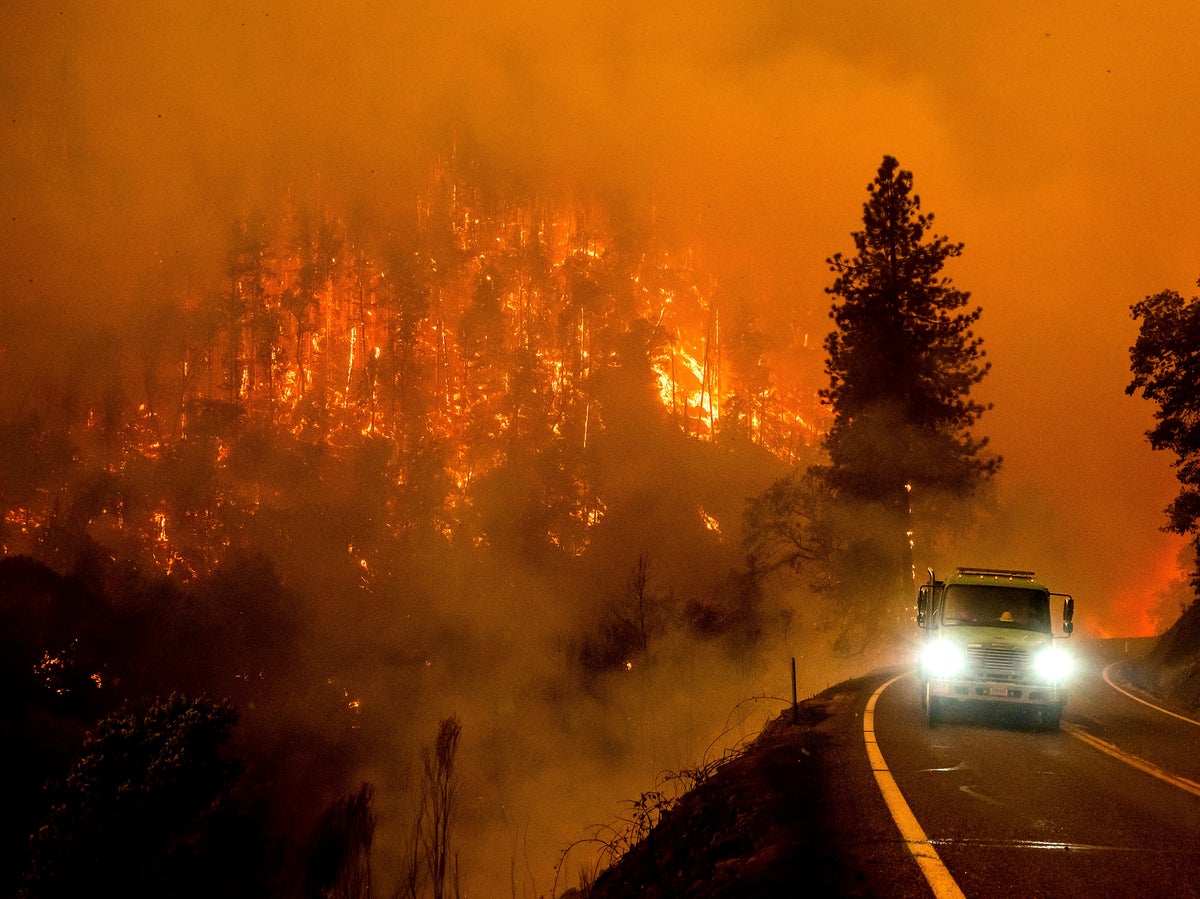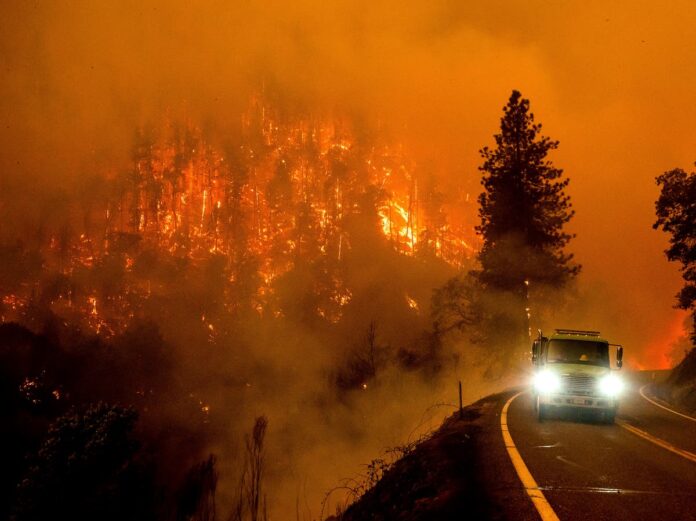[ad_1]

California Governor Gavin Newsom has declared a state of emergency as the McKinney wildfire has now scorched more than 62 square miles in the state.
Wildfires in both California and Montana expanded drastically during the night between Saturday and Sunday as windy and hot weather allowed the fires to close in on neighbourhoods, prompting evacuation orders for 100 homes on Saturday.
A fire in Idaho was also expanding, according to the Associated Press.
The McKinney Fire is taking over the Klamath National Forest in California after starting on Friday. It went from scorching just over one square mile to covering more than 62 square miles (160 square km) on Saturday in a mostly rural part of the state near the border with Oregon, fire officials said.
At least 12 homes were burned down and wildlife could be spotted fleeing the flames.
Klamath National Forest spokeswoman Caroline Quintanilla told the AP that “it’s continuing to grow with erratic winds and thunderstorms in the area and we’re in triple-digit temperatures”.
Angela Crawford leans against a fence as a wildfire called the McKinney fire burns a hillside above her home in Klamath National Forest, Calif., on Saturday, July 30, 2022
(AP)
The state of emergency allows that Mr Newsom more leeway when making decisions relating to the emergency response and allows him to access federal aid.
The office of the governor said in a statement that the declaration allows “firefighting resources from other states to assist California crews in battling the fires”.
The Elmo wildfire in Montana almost tripled its area, now covering more than 11 square miles (28 square km). It’s only a few miles a way from Elmo, a small town in the northwestern parts of the state.
Around 200 miles south (320 km) in Idaho, residents have been ordered to evacuate after the Moose Fire scorched more than 67.5 square miles (175 square km) in the Salmon-Challis National Forest close to the town of Salmon in the northern parts of the state. Containment was at 17 per cent, according to the AP.
Regional US Forest Service spokesperson Tom Stokesberry told the news agency that the McKinney Fire in California was being fueled by vegetation in an area that hasn’t burned for some time.
“It’s a very dangerous fire, the geography there is steep and rugged, and this particular area hasn’t burned in a while”, he said.
He added that another, smaller, fire was burning in the area, close to the town of Seiad. As lighting has been forecasted for the next several days, statewide resources from across California are being pulled in to handle the fires.
The rapid increase in the size of the McKinney fire has prompted firefighters to move from a containment strategy to protecting homes and vital infrastructure, like power lines and water tanks.
Fire crews also helped evacuate Siskiyou, the county covering part of California’s border with Oregon.
Police went doorknocking in Yreka, the county seat, as well as in the town of Fort Jones, where they encouraged residents to leave the area and to move their livestock.
Areas without cell phone service received automated calls to landlines. More than 100 homes were ordered to evacuate. the authorities also warned people to be alert as smoke closed down parts of highway 96.
A firetruck drives along California Highway 96 as the McKinney Fire burns in Klamath National Forest, Calif., Saturday, July 30, 2022
(AP)
The Pacific Coast Trail Association told hikers to go to the closest town as 110 miles (177 km) of the trail was closed between the Etna Summit and the Mt Ashland Campground in the southern parts of Oregon.
Firefighter and Oregon State Representative Dacia Grayber was camping with her husband, also a member of the fire service, close to the border with California when strong winds woke them up shortly after midnight.
The sky was being lit up as lightning pierced the clouds while they were struck by ash blowing in the wind despite them being about 10 miles (16km) from the fire.
Ms Grayber told the AP that “these were some of the worst winds I’ve ever been in and we’re used to big fires”.
“I thought it was going to rip the rooftop tent off of our truck. We got the heck out of there”, she added.
“The terrifying part for us was the wind velocity”, she told the news agency. “It went from a fairly cool breezy night to hot, dry hurricane-force winds. Usually, that happens with a fire during the day but not at night. I hope for everyone’s sake this dies down but it’s looking like it’s going to get worse.”
Western Montana saw the Elmo Fire, egged on by the wind, leading to evacuations of both homes and livestock as the fire scorched grass and trees, The National Interagency Fire Center announced. The center said it would take almost a month to get the blaze under control.
The Montana Department of Transportation said that a part of Highway 28 between Elmo and Hot Springs had been closed because of the smoke.
Firefighters from numerous agencies, such as the Confederated Salish and Kootenai Tribes Fire Division, battled the flames on Saturday. As many as 22 fire engines were on the ground as six helicopters made drops from above.
More than 930 wildland firefighters and supporting staff fought the Moose Fire in Idaho on Saturday in extensive efforts to protect residences, energy infrastructure, and Highway 93.
Forecasts for “dry thunderstorms” – meaning lightning, wind, and no rain – indicated that the situation could worsen.
Firefighters also battled flames on Maui, Hawaii, with the Maui County Emergency Management Agency saying that roads have been closed down as they urged residents and tourists to avoid the area close to Paia Bay.
In the fight against another California fire that prompted the evacuations of thousands near Yosemite National Park earlier in July, fire crews made huge progress – the Oak Fire was 52 per cent contained on Saturday, Cal Fire said.
On Friday, the US House of Representatives approved a bill that would help communities in the west handle the increasing threat of wildfires and drought brought on by the climate crisis. Such incidents have led to billions of dollars in damage to businesses and homes over the course of the last few years.
The legislation combines 49 bills and would boost pay for fire crews, expand projects aimed at increasing the resiliency and the mitigation of the climate crisis in affected areas, it would put in place guarding measures for watersheds, and simplify the process for victims of wildfires to receive federal aid.
Senator Dianne Feinstein, a California Democrat, has sponsored similar legislation in the upper chamber.
[ad_2]
Source link















